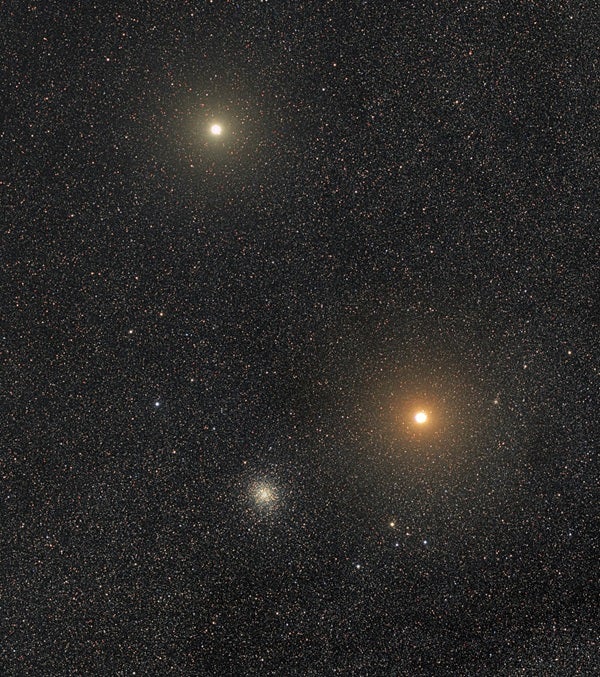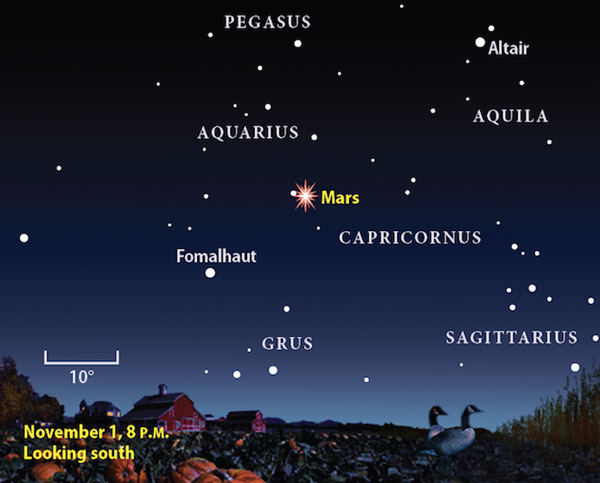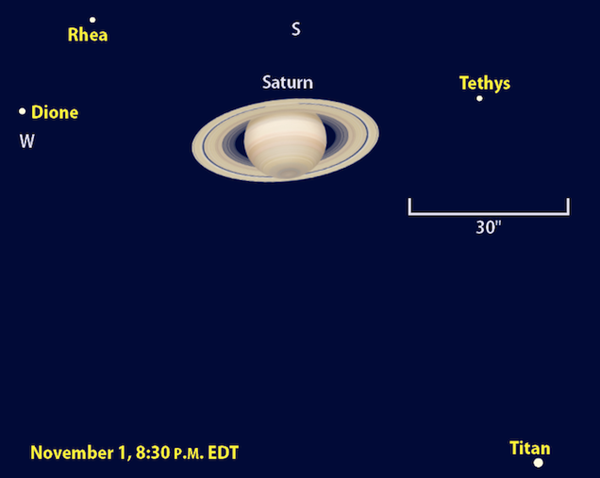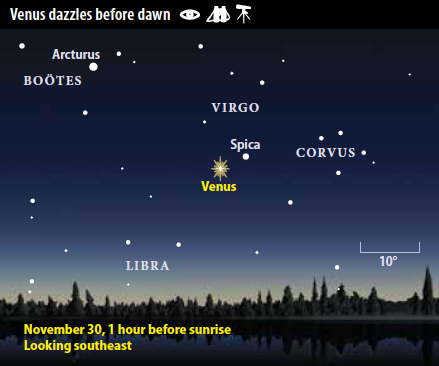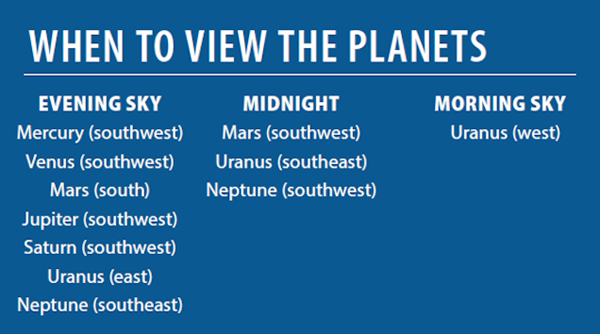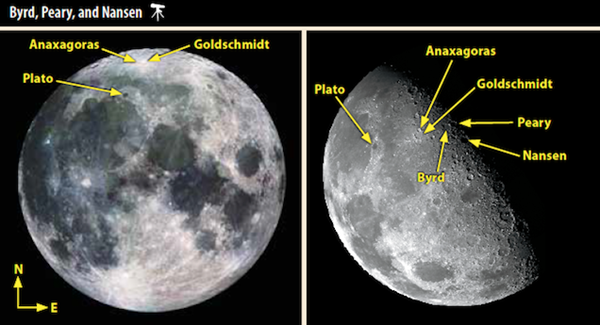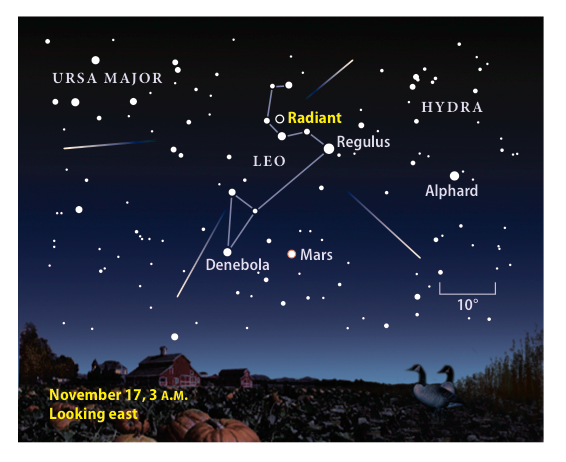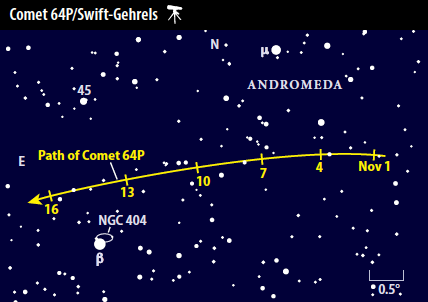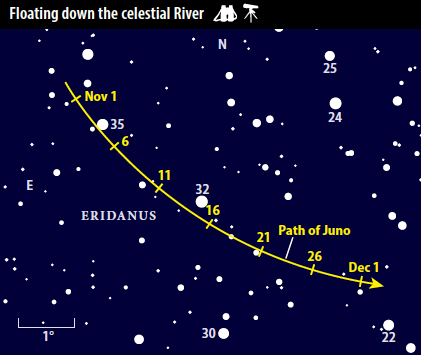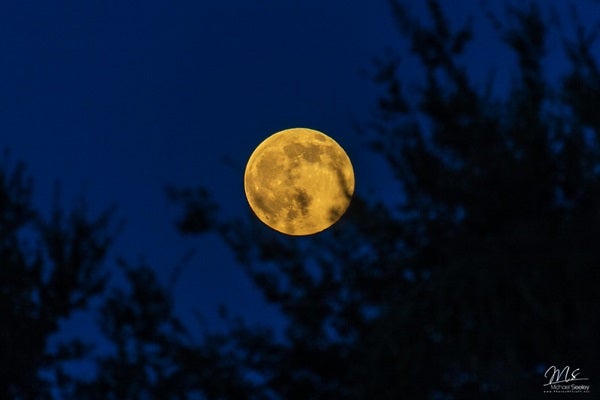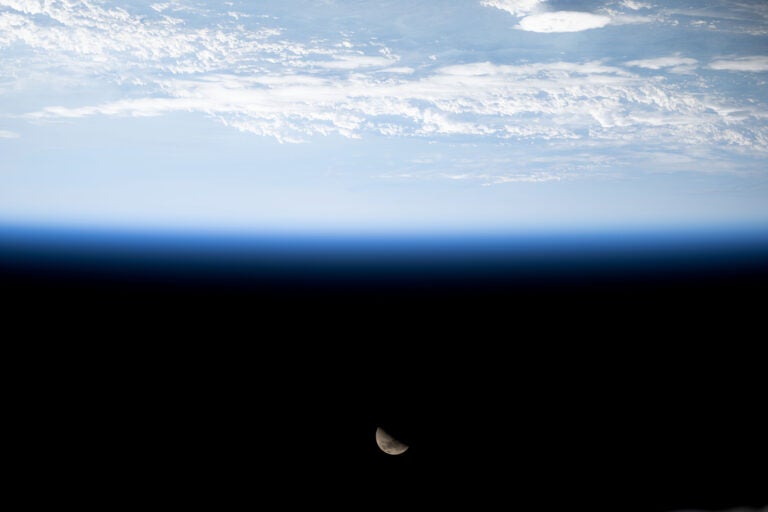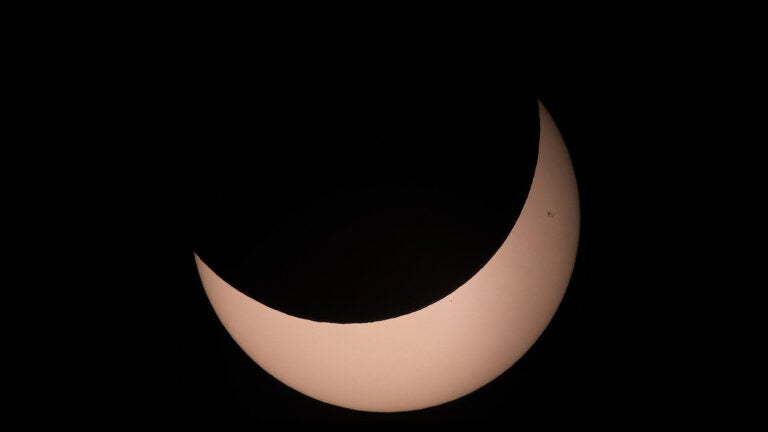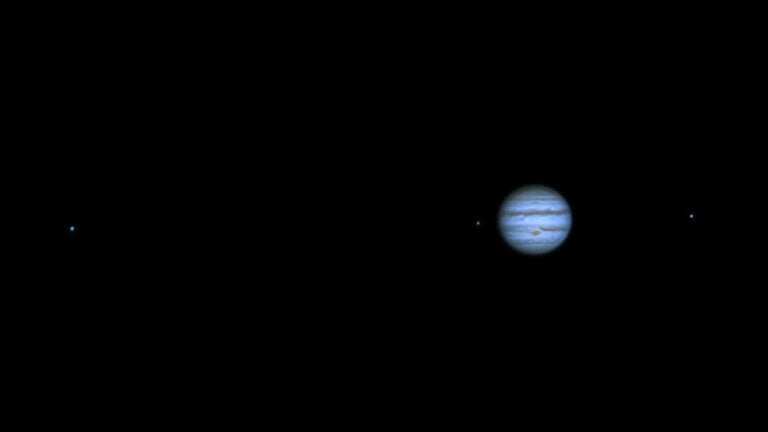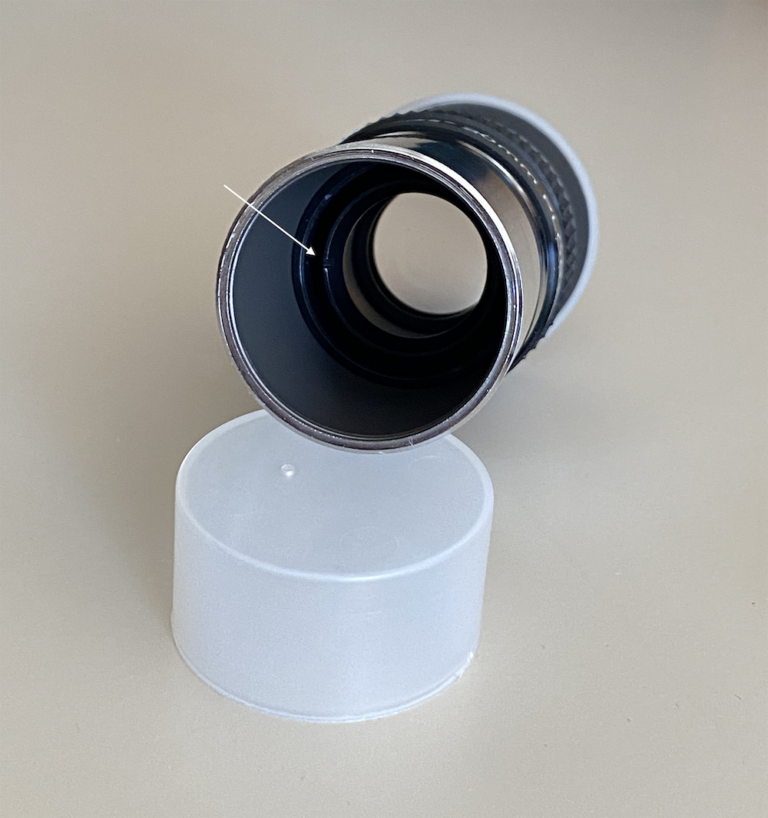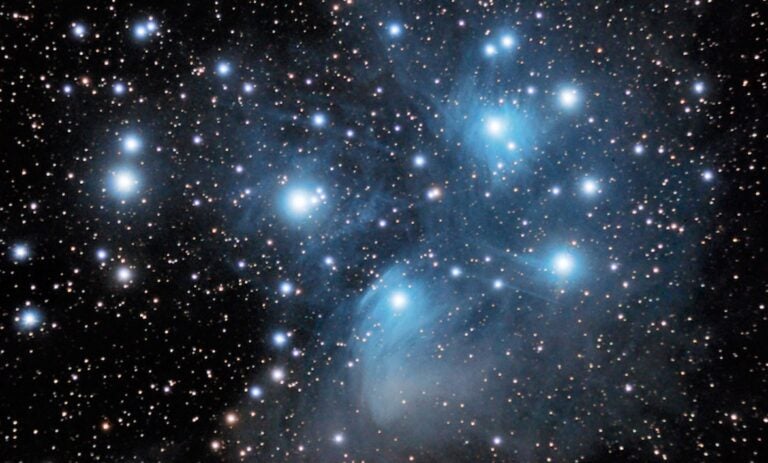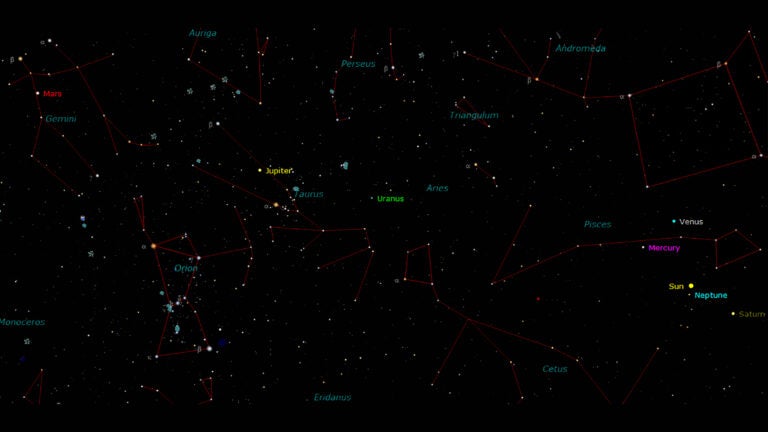To see Mercury and Jupiter, you’ll have to be ready to observe at dusk. Both hug the southwestern horizon in early November, so find a site that offers an unobstructed view in this direction. On the 1st, Jupiter hangs 4° high 30 minutes after sunset and Mercury stands 5° to its left. At magnitude –1.7, Jupiter appears four times brighter than its magnitude –0.2 companion. Plan to use binoculars to observe the planetary pair.
Jupiter vanishes in twilight during November’s second week as it makes its way toward solar conjunction on the 26th. Mercury maintains its altitude through midmonth, however, before our star’s light overwhelms it during November’s third week. The innermost planet passes between the Sun and Earth on the 27th.
You can afford to let the sky darken some before hunting for Saturn. The ringed world stands 20° above the southwestern horizon an hour after sunset in early November. Under a dark sky just 30 minutes later, the background stars of Sagittarius and the central regions of the Milky Way nicely frame the planet. Saturn shines at magnitude 0.5, more than a full magnitude brighter than any of the Archer’s stars.
Be sure to scan this area through binoculars. Several bright star clusters lurk in the region as well as the gorgeous Lagoon and Trifid nebulae (M8 and M20, respectively). These two gas clouds lie just 4° west of Saturn in early November.
You’ll also want to observe the ringed planet through a telescope. The best views come in early evening during November’s first couple of weeks, when it still lies reasonably high. As Saturn sinks lower, its image starts to dance like a bowl of jello. On the 1st, Saturn’s globe measures 16″ across the equator, and the ring system spans 36″.
Pay particular attention to the rings. They currently tip 26.4° to our line of sight, just 0.6° less than at their maximum last year. They tilt this wide open only twice during the planet’s 29.5-year orbit, and will appear slightly thinner next year. So take this opportunity to view the dark Cassini Division that separates the outer A ring from the brighter B ring. Under excellent observing conditions, you also might spot the ghostly C ring closest to the planet. It looks like a faint shadow cast onto the planet’s atmosphere, but in reality it is blocking light reflected from the bright cloud tops.
A telescope also reveals Saturn’s brightest satellites. You can see 8th-magnitude Titan, the planet’s largest and brightest moon, through any scope. A 4-inch instrument also pulls in a trio of 10th-magnitude moons: Tethys, Dione, and Rhea. All three orbit closer to Saturn than their big brother.
Scan one constellation east of Sagittarius, and you’ll be among the relatively inconspicuous stars of Capricornus. But in early November, the Sea Goat hosts stunning Mars, the star of our evening show. The Red Planet shines at magnitude –0.6 and, from mid-northern latitudes, it stands 34° high in the south as the last vestiges of twilight fade away. The orange-colored world doesn’t dip below the horizon until 1 a.m. local daylight time.
Mars’ eastward motion relative to the starry background carries it 0.6° north of magnitude 2.8 Delta (δ) Capricorni on November 5. The planet crosses into neighboring Aquarius on the 11th and, two evenings later, it passes within a Moon’s width of magnitude 4.3 Iota (ι) Aquarii.
By the time November wraps up, Mars glows at magnitude –0.1 and lies 2.5° southwest of magnitude 3.8 Lambda (λ) Aqr. The planet’s rapid easterly motion this month helps it keep pace with the Sun. It still lies due south as evening twilight ends on the 30th, but now at an altitude of 41°.
This higher elevation improves viewing conditions for Northern Hemisphere observers, and partially compensates for the planet’s shrinking size. Mars’ disk spans 11.8″ the evening of the 1st and 9.3″ on the 30th. This is still large enough to show some details through amateur scopes, though it’s a far cry from the 24.3″ at its peak in late July.
Fortunately, two of the planet’s most conspicuous features lie near the center of the martian disk on November’s first few evenings. Look for the dark, wedge-shaped Syrtis Major just north of Mars’ equator. If you see it clearly, you also should notice the bright oval Hallas basin to its south.
While the parade of bright planets attracts attention to the southwest and south these November evenings, the east and southeast quietly introduce the distant ice giant worlds, Neptune and Uranus. Neptune is up first, residing among the background stars of Aquarius some 40° above the southeastern horizon as darkness falls. It stands just 2° from Lambda Aqr, the 4th-magnitude star Mars approaches at the end of the month.
Because Neptune glows at magnitude 7.9, you’ll need binoculars or a telescope to spot it. On the 1st, you can find it 2.1° east of Lambda and 0.3° south-southwest of 6th-magnitude 81 Aqr. The planet creeps westward until the 25th, when it reaches its stationary point 0.1° closer to Lambda. It then heads off on an easterly track for the rest of the year, though its position barely budges by November’s close.
Uranus trails about three hours behind Neptune. It lies in the southwestern corner of Aries the Ram, about 10° due south of 3rd-magnitude Beta (β) Arietis. Uranus shines at magnitude 5.7, so it’s barely visible to the naked eye from under a dark sky and an easy target through binoculars.
Your best bet for finding it is to start at 4th-magnitude Omicron (ο) Piscium in neighboring Pisces. Uranus stands 2.4° northeast of this star November 1 and 1.6° north-northeast of it on the 30th. Don’t confuse the planet with the magnitude 5.9 star SAO 92659. Uranus passes 14′ due south of this star on the 9th. The easiest way to tell the two apart is to point a telescope at them. Only Uranus shows a disk, which spans 3.7″ and sports a distinctive blue-green color.
At just about the same time Uranus dips below the western horizon, Venus appears in the east. Although the inner planet passed between the Sun and Earth during October’s final week, it quickly establishes itself as the brilliant “morning star” in the predawn twilight. On November 1, Venus rises about a half-hour before the Sun. That grows to an hour on the 4th, two hours on the 13th, and three hours on the 25th.
A brightness surge accompanies this quick leap into the morning sky. The inner world shines impressively at magnitude –4.2 in early November but appears twice as bright (magnitude –4.9) by month’s end. The changes to Venus’ telescopic appearance are no less dramatic. On the 1st, the planet spans 61″ and the Sun illuminates just 2 percent of its Earth-facing hemisphere. Its diameter dwindles to 41″ by the 30th while its phase waxes to 25 percent lit.
You’ll want to set your alarm early November 6 to see Venus hanging 9° to the right of a slender crescent Moon. It’s also worth watching from the 11th to the 19th, when the planet approaches within 2° of 1st-magnitude Spica.
Explore the Moon’s north pole
To see the Moon’s poles well, timing is key. The Sun best illuminates these areas near Full Moon, but our satellite also has to be positioned so that one of its poles tips in our direction. The geometry works out perfectly in November to give us a nice view of the lunar north pole.
On the evening of the 22nd, the Full Moon’s orientation will be similar to the Galileo spacecraft image at left. First, pick out the landmark craters Plato, Anaxagoras, and Goldschmidt. Then, let the Galileo image at right guide you to Byrd, then Peary, and finally Nansen. If the weather cooperates the next few nights, return to this region and watch the shadows of the crater rims shift from one side of their southern flanks to the other.
Dark skies to see the Lion roar
The Leonid meteor shower peaks the night of November 17/18. The waxing gibbous Moon sets before 2 a.m. local time and morning twilight starts after 5 a.m., leaving more than three hours of undisturbed viewing. The meteors radiate from the constellation Leo the Lion, which climbs more than 60° high in the southeast before dawn.
The Leonid shower derives from debris ejected over many millennia by Comet 55P/Tempel-Tuttle. This periodic visitor last returned to the inner solar system in 1998, and astronomers don’t anticipate any unusual meteor activity this year. Still, observers under dark skies could see an average of between 15 and 20 meteors per hour.
The Princess’ ghostly apparition
After whetting our appetites for brighter objects later this year, Comet 21P/Giacobini-Zinner has started to fade away. The best of the lot in November should be 64P/Swift-Gehrels, which passes nearly overhead during the evening hours. It should hold us until the year’s brightest comet, 46P/Wirtanen, comes to the fore in December.
Plan to look for Swift-Gehrels during the first half of November when the Moon won’t affect viewing. The comet moves eastward during this period slightly north of the 2nd-magnitude star Mirach (Beta [β] Andromedae). Astronomers think 64P could peak near 10th magnitude, coincidentally near the same total brightness as the nearby elliptical galaxy NGC 404. Observers have dubbed this distant fuzzy the “Ghost of Mirach” because it lies a mere 7′ northwest of Beta and has tricked unwary skywatchers into thinking it was an internal reflection of the star.
Swift-Gehrels should be easier to see than NGC 404, but it depends on how large and diffuse the comet is — the more its light spreads out, the lower its surface brightness and the harder it is to see. Use a 4-inch or larger telescope and medium power (at least 100x) to darken the background sky and make the comet appear larger. Then try averted vision (glancing to the side of the field) to take advantage of your eye’s sensitive peripheral vision.
Juno makes a historic return
Asteroid 3 Juno reaches opposition November 17. But this is no ordinary opposition — Juno peaks at magnitude 7.4, the brightest it has been since October 1983.
Juno rises during twilight and by midevening appears in the southeastern sky to the lower right of Aldebaran. The asteroid resides in northern Eridanus the River, a region lacking in prominent stars. In fact, only a handful of the stars in the finder chart are brighter than Juno. You should be able to pick out the asteroid based solely on its location plotted below. If in doubt, sketch the four or five brightest objects in your telescope’s field of view. Come back a night or two later and find the “star” that has shifted position. That is Juno.
Use 5th-magnitude 35 Eridani as a guide during November’s first week. On the 4th, Juno lies 0.1° southeast of this star and the same distance northwest of a fainter star. The three objects form a straight line that changes noticeably in less than an hour as Juno heads southwest. In mid-November, the asteroid passes the magnitude 4.7 star 32 Eri. Juno remains within 0.5° of this star from November 13–16.

